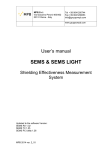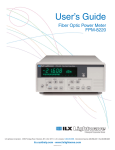Download Measurement Specialties 101 Specifications
Transcript
Operating Manual Model 101 3-Channel DC Signal Conditioner Amplifier Measurement Specialties, Inc. Vibration Sensors Design Center 32 Journey, Suite 150 Aliso Viejo, CA 92656 USA Tel: 949-716-5377 www.meas-spec.com [email protected] Operating Manual Model 101, Revision 1 Page 1 of 14 Table of Contents Warranty ...........................................................................................................................3 Safety .............................................................................................................................. 4 Description ...................................................................................................................... 5 Specifications .................................................................................................................. 6 Wiring Information ........................................................................................................... 7 Front Panel ...................................................................................................................... 9 Rear Panel ..................................................................................................................... 10 Setting Up the Model 101 .............................................................................................. 11 Location of Filter Modules and Rsh Resistors ............................................................... 14 Operating Manual Model 101, Revision 1 Page 2 of 14 Warranty Measurement Specialties, Inc. instruments are warranted during a period of one year from date of shipment to original purchaser to be free from defects in material and workmanship. The liability of Seller under this warranty is limited to replacing or repairing any instrument or component thereof which is returned by Buyer, at Buyer’s expense, during such period and which has not been subjected to misuse, neglect, improper installation, repair, alteration, or accident. Seller shall have the right to final determination as to the existence and cause of a defect. In no event shall Seller be liable for collateral or consequential damages. This warrant is in lieu of any other warranty, expressed, implied, or statutory; and no agreement extending or modifying it will be binding upon Seller unless in writing and signed by a duly authorized officer. Receiving Inspection Every Measurement Specialties, Inc. instrument is carefully inspected and is in perfect working condition at the time of shipment. Each instrument should be checked as soon as it is received. If the unit is damaged in any way, or fails to operate, a claim should immediately be filed with the transportation company. Service Concerns If a Measurement Specialties, Inc. instrument requires service, first contact the nearest Measurement Specialties, Inc. representative. They may be able to solve the problem without returning the unit to the factory. If it is determined that factory service is required, call Customer Service at the regional headquarters for an RMA number before return. Operating Manual Model 101, Revision 1 Page 3 of 14 Returns All units being returned to the factory require an RMA (Return Material Authorization) number before they will be accepted. This number may be obtained by calling Customer Service at the regional headquarters with the following information; model number(s), quantity, serial number(s), and symptoms of the problem, if being returned for service. You must include the original purchase order number if under warranty. Inquiries Address all inquiries on operation or applications to the End User Applications Support as follows: Global Headquarters 1000 Lucas Way Hampton, VA 23666, USA Tel: +1 757 766 1500 Vibration Sensors Design Center 32 Journey, Suite 150 Aliso Viejo, CA 92656, USA Tel: +1 949 716 5377 European Headquarters 105 av. du Général Eisenhower BP 1036, 31023 Toulouse Cedex, France Tel: +33 (0) 561 194 543 Asian Headquarters Measurement Specialties (China), Ltd. F1.6-4D, Tian An Development Compund Shenzhen, China 518048 Tel: +86 755 8330 1004 Email: [email protected] Web: www.meas-spec.com/vibration Safety Read this manual in its entirety before operating the Model 101 Signal Conditioner. Read all wiring and power hookup instructions and understand the requirements prior to using another manufacturer's products with the Model 101. Insure that any product being interfaced with the Model 101 is wired according to prevailing local safety and operational standards before operating. The following symbols and terms may be found on the Model 101 and its manuals and indicate important information. When found on the device, this symbol indicates that the operator should refer to the manual for important instructions on the proper use of this device. When found in the manual, this symbol indicates that the reader should understand the implications contained in the text before operating the device. This symbol indicates that a shock hazard may be present. Read the instruction manual carefully and insure that the device is wired properly and that all settings have been checked prior to applying power to the device. The WARNING label indicates important information that should be heeded for safe and proper performance of the device. The CAUTION label is used to indicate that damage to the power supply or equipment connected to it could occur if directions are not followed. Warranty could be invalidated if the instructions in this manual are not followed. Disassembling the Instrument Turn Input Power Switch OFF before removing power cable from the instrument. Remove power cable from instrument before disassembling any part of the instrument. Grounding To avoid electrical shock, the power cord protective grounding conductor must be connected to power ground. Fuse Replacement For continued fire protection, replace fuse only with the specific type and rating by qualified personnel (Reference Manual "Rear Panel" section). Disconnect the power cord before replacing fuse. Operating Manual Model 101, Revision 1 Page 4 of 14 Description The Model 101 is a new, microprocessor-controlled, 3-Channel DC Signal Conditioner Amplifier designed to be used with bridge type or differential output accelerometers and pressure transducers. The Model 101 incorporates variable gain adjustment, shunt calibration capability, and multiple excitation level settings. For various applications where specific frequency roll-off is required, the Model 101 offers a variety of optional filter modules. Measurement Specialties new 3-Channel DC Signal Conditioner offers a multitude of features in a simple bench top enclosure for ease of use. The Model 101 utilizes a microprocessor SLEEP mode to eliminate high frequency clock noise and their associated harmonics. The microprocessor WAKES momentarily to acknowledge front panel switch depressions then goes to SLEEP immediately after processing and executing the requested function. This allows the amplifiers to operate with minimum self generated noise and provides clean, clock free amplified signals. The Model 101 uses dual 12-bit DAC's, for each channel, to autozero the input and output amplifiers for DC input signals. Input signals with magnitudes of +/-10 Vdc can be zeroed. Unzeroing the amplifier zeroes both autozero DAC's. A unique output DAC trimming routine, allows trimming the output zero to within +/-1mVdc. Dual 12-bit DAC's, for each channel, are also used to set amplifier gains from 0.00 to 999.9 with +/-0.5% precision. Amplifier gains can be changed "on the fly" without damage to the instrument. Each of the 3 amplifiers has a 150kHz full power and a 200kHz small signal bandwidth and can drive 10mA into a 1K ohm load. A low pass filter socket is provided, for each amplifier, to filter broadband noise. A variety of optional filter modules can be installed in these sockets. The transducer excitation supplies are individually adjustable for each channel from 0.00 to 12.00Vdc. Any setting above 12.00Vdc will generate an excitation voltage of 12.10Vdc. The outputs are short circuit protected and can supply up to 30mA each. Remote sense leads are provided to eliminate errors caused by long cable lengths. The Model 101 has been CE tested for compliance to EN61326 for EMC emissions and immunity and EN61010-1:2001 for Product Safety. Consult Measurement Specialties Application Engineers for associated optional filter modules and cable assemblies to mate with the Model 101. Operating Manual Model 101, Revision 1 Page 5 of 14 Specifications Input Specifications Input Range Input Impedance Common Mode Input Range Common Mode Rejection Autozero Adjustment Range Autozero Accuracy Output Specifications AC/DC Voltage Output Impedance Linear Output Current Output Output DC Bias Temp Stability Output DC Bias Time Stability Excitation Voltage Excitation Voltage Accuracy Excitation Current Noise & Ripple Transfer Characteristics Gain Range Resolution Accuracy Linearity Noise Frequency Response Filter Crosstalk Between Channels Power Requirements Voltage Current Rating Isolation Physical Characteristics Dimensions Weight (w/o power cord) Case Material Operating Manual Model 101, Revision 1 Differential 0 to +/-10Vdc or peak Vac, 9-pin D-sub connector for each bridge sensor > 1 Megohm minimum +/- 10Vdc or peak Vac, inclusive of signal 50V peak without damage 70db minimum, 200 ohms or less imbalance, DC to 60kHz, gain >100 20db typ, 200 ohms or less imbalance, DC to 60kHz, gain =1 +/-10mVdc for gain<1000 +/-100mVdc for gain≤100 +/-1Vdc for gain ≤10 +/-10Vdc for gain ≤1 Within +/-50mV (typ) Single ended, short circuit protected, isolated from power ground 0.2 ohms max 10Vpeak 10mA min +/-5uV/degC RTI or +/-0.1mV/degC RTO whichever is greater +/-20uV RTI or 5mV RTO, whichever is greater for 24hrs, after 1hr warmup 0 to 12Vdc, front panel selectable for each channel +/-1% (0 to 10Vdc), +/-5% (12Vdc) 30mA maximum per channel, short circuit protected 1mVrms maximum, 10Hz to 50kHz, with 1 kOhm load 0.00 to 999.9 For 0 ≤ gain <10, 0.00 to 9.99 For 10 < gain <100, 10.00 to 99.99 For 100 < gain <1000, 100.0 to 999.9 +/-0.5% of full scale (max), DC to 1kHz, filters disabled +/-0.1% of full scale, best fit straight line at 1kHz reference 20uVrms RTI plus 1mVrms RTO, whichever is greater DC to 50 kHz, with a 1kohm source resistance unit (with 10 kHz internal low pass filter enabled) DC to 150 kHz (full power bandwidth), -3db referenced to 1kHz Plug in module (optional) 80 db RTI 100/115/230V~, 50/60 Hz, rear panel switch selectable 0.1/0.1/0.05 A No isolation channel to channel or signal ground to case ground 8.25”w x 3.25”h x 9.25”d (210 x 83 x 235mm) 3.4lbs (1.5kg) Iridited aluminum Page 6 of 14 Wiring Information CH1, CH2 and CH3 (9-Pin Standard D-Subminiature) Transducer Connector 1 - Sense(+) 2 - NC 3 - NC 4 - Vin(-) 5 - Vin(+) Note: Vin(+) and Vin(-) are fully differential inputs 6 - Sense(-) 7 - Vexc(+) 8 - Vexc(-) Note: Vexc(-) is connected to analog ground. 9 - NC Recommended Hookup for Bridge Type Sensors (Sense leads wired for optimum performance) Typical Hookup for Bridge Type Sensors (Alternate sense lead wiring) Operating Manual Model 101, Revision 1 Page 7 of 14 Wiring Information CH1, CH2 and CH3 Output BNC Connector (50 ohm) Typical Hookup to Oscilloscope Note: The Model 101 Signal Ground is isolated from power ground. This allows connecting the oscilloscope Power Ground to the 101 Signal Ground. To minimize high frequency EMI susceptibility, install clamp-on ferrites with frequency bands of 80MHz to 800MHz. Operating Manual Model 101, Revision 1 Page 8 of 14 Front Panel SW1 (Gain / Excitation) SW2 (Shunt Cal Switch) SW3 (Channel Select Switch) LED1 (Channel Select LED) SW4 (Zero / Unzero Switch) SW5 (Set Gain Switch) SW6 (Set Vexc Switch) LED2 (Power On LED) Operating Manual Model 101, Revision 1 Sets Gain from 0.00 to 999.9 or Vexc from 0.00 to 12.00Vdc Activates Shunt Cal Relay and Internal Shunt Cal Resistor Used to select Channel to update Illuminates when corresponding Channel is selected Zeroes, Unzeroes, or Trims Zero of selected Channel Sets Gain to Thumbwheel Switch setting of selected Channel Sets Vexc to Thumbwheel Switch setting of selected Channel Illuminates when V~, 50/60 Hz input power is applied Page 9 of 14 Rear Panel Operating Manual Model 101, Revision 1 Page 10 of 14 Setting Up the Model 101 To setup CH1, CH2 or CH3, perform the following steps in the sequence shown. Step 1: Set Vexc 1. Set the GAIN/EXCITATION Thumbwheel Switch (SW1) to desired Vexc. Note: If the Thumbwheel Switch is set to a value >12.00, Vexc will be 12.10 Vdc. For 0.00 < or = Thumbwheel Switch Setting < or = 12.00, Vexc will be equal to the Thumbwheel Switch Setting, when selected. 2. Depress the Channel Select Switch for CH1, CH2 or CH3. The appropriate Channel Select LED will illuminate and stay illuminated. 3. Depress the SET Vexc Switch (SW6). The Channel Select LED will extinguish and Vexc for the selected channel will be set to the Thumbwheel Switch setting. Example: Set Thumbwheel Switch to 009.75. Depress CH2 switch, then the SET Vexc Switch. Vexc for CH2 should be 9.75Vdc +/-1%. Step 2: Set Amplifier Gain 1. Set the GAIN/EXCITATION Thumbwheel Switch (SW1) to desired amplifier gain. Note: The amplifier gain can be set anywhere from 0.00 to 999.9. 2. Depress the Channel Select Switch for CH1, CH2, or CH3. The appropriate Channel Select LED will illuminate and stay illuminated. 3. Depress the SET GAIN Switch (SW5). The Channel Select LED will extinguish and the selected channel gain will be set to the Thumbwheel Switch setting. Example: Set the GAIN/EXCITATION Thumbwheel Switch to 075.00. Depress CH2 switch, then the SET GAIN switch. CH2 gain will be set to 75.00. Step 3: Zero the Amplifier 1. Verify the input to the appropriate channel is the desired input to be zeroed. Note: Any DC input signal, within the specified operating range of the amplifier can be zeroed. 2. Depress the Channel Select Switch CH1, CH2, or CH3. The appropriate Channel Select LED will illuminate and stay illuminated. 3. Depress and release the ZERO Switch (SW4). 4. The amplifier, under microprocessor control, will first zero the output of the input amplifier, then zero the output of the output amplifier. The output will be 0.00 +/- 0.050Vdc (typ). Operating Manual Model 101, Revision 1 Page 11 of 14 Step 4: Trimming the Zero output Note: Trimming allows the user to zero the output of the selected channel to within ±1mVDC. This trimmed value may then be stored in non-volatile memory and reapplied upon power turn on. 1. Perform Step 3: Zero the Amplifier. 2. Depress and hold depressed, the Channel Select Switch for CH1, CH2 or CH3. The appropriate Channel Select LED will illuminate and stay illuminated. 3. To increment the output zero by 1 count of the output zero DAC, set the GAIN/EXCITATION Thumbwheel Switch (SW1) to " 0 0 0. 0 1 ". To decrement the output zero by 1 count of the output zero DAC, set the GAIN/EXCITATION Thumbwheel Switch (SW1) to " 0 0 1. 0 1 ". 4. Depress the ZERO switch. The output zero will increment or decrement by 1 count of the output zero DAC. Successive depressions of the ZERO switch will continue to increment or decrement the output zero. Note: To increment the output zero by (x) counts of the output zero DAC, set the GAIN/EXCITATION Thumbwheel Switch (SW1) to " 0 0 0. 0 x " and depress the ZERO switch. To decrement the output zero by (x) counts of the output zero DAC, set the GAIN/EXCITATION Thumbwheel Switch (SW1) to " 0 0 1. 0 x " and depress the ZERO switch. 5. To save the trimmed zero value in non-volatile memory, depress and hold depressed the Channel Select switch again. The selected channel LED will extinguish. The trimmed zero value will be stored in non-volatile memory. Note: If any other channel is selected before the selected channel switch is depressed and held, the trimmed zero value will not be saved and the previously stored zero value will be used at power up. Operating Manual Model 101, Revision 1 Page 12 of 14 Setting Up the Model 101 Unzeroing the desired channel. Note: Unzeroing the desired channel sets both autozero DAC's to zero. This basically sets the amplifier to its natural zero position. The output of the amplifier is offset by its own offset voltage. Step 1: Unzero the amplifier 1. Depress the Channel Select Switch for CH1, CH2 or CH3. The appropriate Channel Select LED will illuminate and stay illuminated. 2. Depress and hold the ZERO Switch (SW4) until the appropriate Channel Select LED extinguishes. The selected Channel amplifier is unzeroed. Applying an internal shunt calibration resistor (Rsh) to the selected channel bridge network. Note: Internal solder jumpers allow for a positive or negative responding Rsh. The shunt cal resistors are removable and may be installed by the user. Reference Location of Filter Modules and Rsh Resistor in the following page. Turn Input Power Switch OFF before removing power cable from the instrument. Remove power cable from the instrument before disassembling any part of the instrument. 1. Simply depress and hold the Rsh Switch for the desired channel amplifier. The shunt cal resistor is applied to the appropriate transducer bridge circuit terminals for the duration that the Rsh Switch is depressed. Operating Manual Model 101, Revision 1 Page 13 of 14 Location of Filter Modules and Rsh Resistors Operating Manual Model 101, Revision 1 Page 14 of 14























